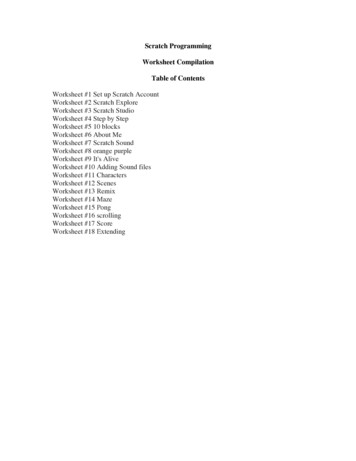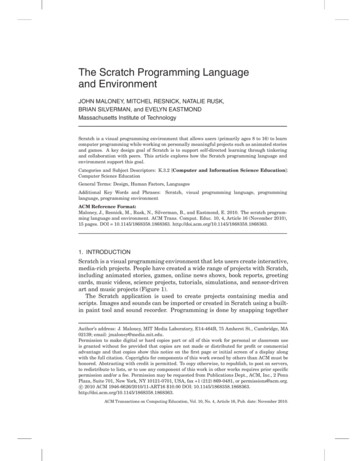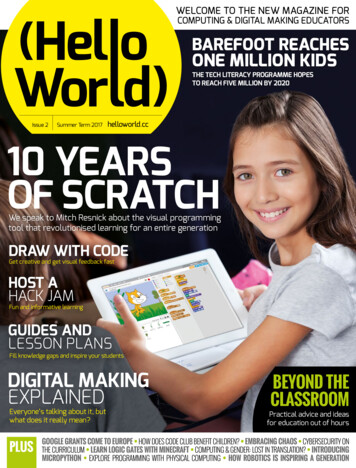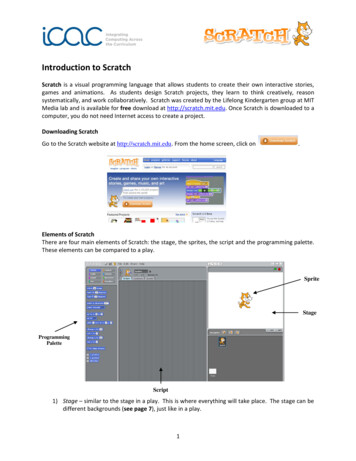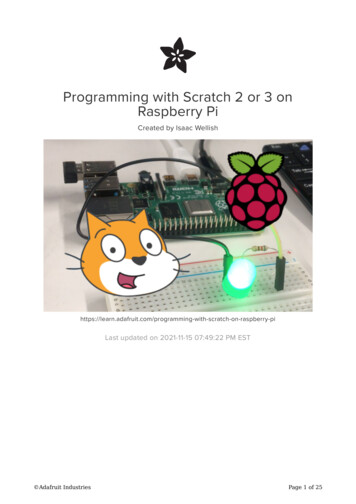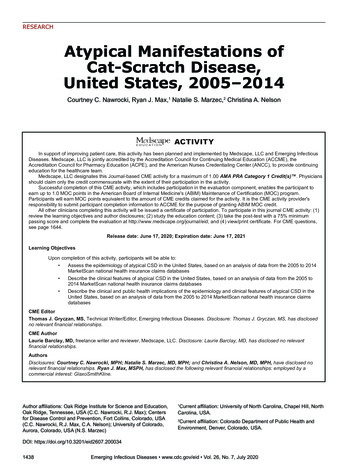
Transcription
RESEARCHAtypical Manifestations ofCat-Scratch Disease,United States, 2005–2014Courtney C. Nawrocki, Ryan J. Max,1 Natalie S. Marzec,2 Christina A. NelsonIn support of improving patient care, this activity has been planned and implemented by Medscape, LLC and Emerging InfectiousDiseases. Medscape, LLC is jointly accredited by the Accreditation Council for Continuing Medical Education (ACCME), theAccreditation Council for Pharmacy Education (ACPE), and the American Nurses Credentialing Center (ANCC), to provide continuingeducation for the healthcare team.Medscape, LLC designates this Journal-based CME activity for a maximum of 1.00 AMA PRA Category 1 Credit(s) . Physiciansshould claim only the credit commensurate with the extent of their participation in the activity.Successful completion of this CME activity, which includes participation in the evaluation component, enables the participant toearn up to 1.0 MOC points in the American Board of Internal Medicine's (ABIM) Maintenance of Certification (MOC) program.Participants will earn MOC points equivalent to the amount of CME credits claimed for the activity. It is the CME activity provider'sresponsibility to submit participant completion information to ACCME for the purpose of granting ABIM MOC credit.All other clinicians completing this activity will be issued a certificate of participation. To participate in this journal CME activity: (1)review the learning objectives and author disclosures; (2) study the education content; (3) take the post-test with a 75% minimumpassing score and complete the evaluation at http://www.medscape.org/journal/eid; and (4) view/print certificate. For CME questions,see page 1644.Release date: June 17, 2020; Expiration date: June 17, 2021Learning ObjectivesUpon completion of this activity, participants will be able to: Assess the epidemiology of atypical CSD in the United States, based on an analysis of data from the 2005 to 2014MarketScan national health insurance claims databases Describe the clinical features of atypical CSD in the United States, based on an analysis of data from the 2005 to2014 MarketScan national health insurance claims databases Describe the clinical and public health implications of the epidemiology and clinical features of atypical CSD in theUnited States, based on an analysis of data from the 2005 to 2014 MarketScan national health insurance claimsdatabasesCME EditorThomas J. Gryczan, MS, Technical Writer/Editor, Emerging Infectious Diseases. Disclosure: Thomas J. Gryczan, MS, has disclosedno relevant financial relationships.CME AuthorLaurie Barclay, MD, freelance writer and reviewer, Medscape, LLC. Disclosure: Laurie Barclay, MD, has disclosed no relevantfinancial relationships.AuthorsDisclosures: Courtney C. Nawrocki, MPH; Natalie S. Marzec, MD, MPH; and Christina A. Nelson, MD, MPH, have disclosed norelevant financial relationships. Ryan J. Max, MSPH, has disclosed the following relevant financial relationships: employed by acommercial interest: GlaxoSmithKline.Author affiliations: Oak Ridge Institute for Science and Education,Oak Ridge, Tennessee, USA (C.C. Nawrocki, R.J. Max); Centersfor Disease Control and Prevention, Fort Collins, Colorado, USA(C.C. Nawrocki, R.J. Max, C.A. Nelson); University of Colorado,Aurora, Colorado, USA (N.S. Marzec)Current affiliation: University of North Carolina, Chapel Hill, NorthCarolina, USA.1Current affiliation: Colorado Department of Public Health andEnvironment, Denver, Colorado, USA.2DOI: https://doi.org/10.3201/eid2607.2000341438Emerging Infectious Diseases www.cdc.gov/eid Vol. 26, No. 7, July 2020
Atypical Manifestations of Cat-Scratch DiseaseAtypical manifestations that can be severe and difficultto diagnosis develop in 5%–20% of patients with catscratch disease. To clarify the epidemiology of atypicalcat-scratch disease in the United States, we analyzeddata from the 2005–2014 MarketScan national healthinsurance claims databases by using the InternationalClassification of Diseases, 9th Revision, Clinical Modification, codes for cat-scratch disease and selectedatypical manifestations: retinitis/neuroretinitis, conjunctivitis, neuritis, encephalitis, hepatosplenic disease,osteomyelitis, erythema nodosum, and endocarditis.Atypical cat-scratch disease accounted for 1.5% of allcases, resulting in an average annual incidence of 0.7cases/100,000 population. Atypical cat-scratch diseasewas associated with increased risk for hospitalization(risk ratios 8.77, 95% CI 6.56–11.72) and occurredmost often in female patients 10–14 years of age. Ocular (48.7%), hepatosplenic (24.6%), and neurologic(13.8%) manifestations were most common among patients. A more comprehensive understanding of atypicalcat-scratch disease can improve patient diagnosis andpotentially elucidate pathophysiology of the disease.Cat-scratch disease, a zoonotic bacterial infection,occurs worldwide and is caused by Bartonellahenselae, a fastidious, intracellular gram-negative bacillus (1). Cats are the major reservoir of B. henselaeand are infected by Ctenocephalides felis cat fleas. Although most cats infected with B. henselae are asymptomatic, signs such as fever and myocarditis mightdevelop in some cats (2,3). Humans usually becomeinfected through the scratches or bites of infected cats.B. henselae has also been shown to infect dogs (4), insome cases resulting in canine endocarditis (5–7). Although some human cases of cat-scratch disease havebeen linked to canine–human transmission (8–12),further research is needed to clarify the public healthsignificance of B. henselae infection in dogs.The true burden of cat-scratch disease in theUnited States is unknown because it is not a reportable condition; however, efforts have been made toestimate its incidence in the United States. In 1993,an analysis of hospital discharge data estimated anationwide incidence of hospitalized cases of 0.77–0.86 cases/100,000 population annually (13). A subsequent study that examined a database of nationalhealth insurance claims during 2005–2013 found thatincidence of cat-scratch disease in the United Stateswas highest in southern states (6.4 cases/100,000population) and in children 5–9 years of age (9.4 cases/100,000 population) (14).Cat-scratch disease typically manifests as feverand an erythematous papule at the site of the catscratch or bite, followed by lymphadenopathy in theregional lymph nodes that drain the area of inoculation (15). The papule usually appears 3–10 days afterinoculation and can persist for several weeks, withregional lymphadenopathy developing 1–3 weekspostinoculation (1). From 80% to 95% of cases of catscratch disease are consistent with this typical presentation, and the remainder of cases manifest as atypicaland more severe symptoms (16,17).Atypical manifestations of cat-scratch disease caninvolve the eyes, nervous system, heart, liver, spleen,skin, or musculoskeletal system and might result inmajor illness (1,15). When cat-scratch disease involvesthe eye, the anterior compartment might be affectedby Parinaud oculoglandular syndrome, and the posterior compartment might be affected by retinitis,retinochoroiditis, optic neuritis, uveitis, and vitritis(18–20). Nervous system involvement most commonly manifests as encephalopathy, but seizures, nervepalsies, neuritis, myelitis, and cerebellar ataxia havealso been reported (21,22).Endocarditis is more often seen in adults withcat-scratch disease than in children, although preexisting valvular disease puts children at increasedrisk for this complication (1). Bartonella infectioncan also cause abdominal pain and microabscessesin the liver and spleen (23), and in immunocompromised hosts can result in bacillary peliosis hepatis(24). In addition to the classic erythematous papuleat the site of inoculation, erythema nodosum andbacillary angiomatosis are reported dermatologicmanifestations of atypical infection (25,26). Osteolytic lesions, osteomyelitis, and arthritis have alsobeen associated with cat-scratch disease (16,24,26).A study in 1998 found cat-scratch disease to be thethird leading cause of prolonged fever of unknownorigin in children, and a history of cat exposure wasfrequently absent (27).Atypical manifestations of B. henselae infectioncan be severe, difficult to diagnose, and lead to lasting impairment. It is unclear why certain patients develop atypical cat-scratch disease, and little is knownabout its epidemiology. Improved understanding ofatypical cat-scratch disease could lead to better recognition of cases by clinicians and inform efforts tounderstand the pathophysiology of this disease. Thepurpose of this study was to better characterize therare and serious complications of this nonreportablezoonotic infection by using nationwide insuranceclaims data.MethodsTo identify potential cases of atypical cat-scratchdisease, we conducted a retrospective analysis ofEmerging Infectious Diseases www.cdc.gov/eid Vol. 26, No. 7, July 20201439
RESEARCHpersons enrolled in the Truven Health MarketScanCommercial Claims and Encounters Database (Truven Health Analytics, https://www.ibm.com) during 2005–2014. The MarketScan Commercial Claimsand Encounters Database includes persons 65years of age covered by select employer-sponsoredhealth insurance plans in all 50 states and containsadministrative claims data on outpatient visits,inpatient admissions, and emergency departmentvisits. Demographically, the MarketScan population generally mirrors the US population, with aslight overrepresentation of persons 50–59 yearsof age and a slight underrepresentation of persons20–29 years of age (28).Billing codes from outpatient, inpatient, andemergency department visits are assigned by either aclinician or billing specialist according to the International Classification of Diseases, 9th Revision, ClinicalModification (ICD-9-CM), and procedures are captured as either ICD-9-CM codes, Current ProcedureTerminology codes, or Healthcare Common Procedure Coding System codes. Because the InternationalClassification of Diseases, 10th Revision, ClinicalModification, was not officially adopted in the UnitedStates until 2015, those codes were not included.We identified cat-scratch disease cases by extracting all enrollee visit records during the study period with an ICD-9-CM code for cat-scratch disease(078.3). The first instance of a 078.3 diagnosis code in apatient record was considered the index event. Atypical manifestations of interest were selected for analysis if they had recorded precedent in the literatureas a complication of cat-scratch disease and distinct,clearly discernable ICD-9-CM codes associated withthe specific manifestation. Based on these criteria,the known complications of cat-scratch diseases included for analysis were endocarditis, osteomyelitis,erythema nodosum, conjunctivitis, retinitis/neuroretinitis, encephalitis, neuritis, and hepatosplenic disease.We included ICD-9-CM codes associated withoptic neuritis in the retinitis/neuroretinitis category.Encounters with an ICD-9-CM code for cat-scratchdisease and an accompanying diagnostic code to indicate the anatomic location of a wound or inoculationsite for B. henselae were also flagged for analysis andwere categorized as either head or neck region, armor shoulder region, leg or hip region, or torso region.We compiled a detailed list of all ICD-9-CM codesused to identify atypical manifestations of cat-scratchdisease (Appendix Table, 1.pdf).We extracted insurance billing records of enrollees with ICD-9-CM codes for cat-scratch disease and1440selected manifestations at either the same encounteror within a 30-day window of one another. These records were evaluated along with previous and subsequent records by 2 independent reviewers (R.J.M. andC.A.N.) to ensure that the clinical picture was consistent with the coded atypical manifestation based ondiagnosis codes, procedure codes, and provider types.If plausible alternative causes of the selected manifestation or likely coding errors were identified, we didnot include the enrollee record as an atypical case. Incases of discordance, a third reviewer (Paul Mead) determined final categorization based on record review.We included persons with an ICD-9-CM codefor cat-scratch disease but without accompanyingatypical manifestation as typical cases for comparison. Residence in a rural area was assigned if anenrollee did not reside in a metropolitan statisticalarea, as designated by the US Office of Managementand Budget. Because previous research has identified increases in cat-scratch disease in late summer,fall, and January (13,14,29), we categorized month ofonset as either late summer and fall, January, or allother months for analysis.We performed descriptive and comparativestatistical analyses by using JMP version 13.2.1(https://www.jmp.com) and SAS version 9.3(https://www.sas.com). We used Pearson χ2 testsor Fisher exact tests for comparisons of categoricalvariables. To compare the conditional probabilityof having atypical cat-scratch disease across strataof potential variables of interest (e.g., sex, age category), we calculated risk ratios (RRs) and associated 95% CIs. Human subjects review at the Centers for Disease Control and Prevention determinedthat institutional review board approval was notrequired for this study.ResultsStudy Population and IncidenceDuring 2005–2014, the MarketScan database contained a median of 44,488,485 (range 16,159,068–53,131,420) enrollees each year. Of 14,824 cat-scratchdisease cases identified from MarketScan during thisperiod, 224 (1.5%) cases were classified as atypical(Table 1). The average annual incidence of atypicalcat-scratch disease diagnoses during the study periodwas 0.7 cases/100,000 population.Atypical cat-scratch disease was most commonamong adults 15–49 years of age (47.3%), and patientswith atypical cat-scratch disease were more likely tobe hospitalized than those with typical manifestations (p 0.0001).Emerging Infectious Diseases www.cdc.gov/eid Vol. 26, No. 7, July 2020
Atypical Manifestations of Cat-Scratch DiseaseTable 1. Characteristics of patients with cat-scratch disease and risk factors for development of atypical cat-scratch disease, UnitedStates, 2005–2014CharacteristicTypical disease, no. (%), n 14,600 Atypical disease, no. (%), n 224Risk ratio (95% CI)*SexM5,583 (38.2)94 (42.0)1.17 (0.90–1.52)F9,017 (61.8)130 (58.0)ReferentAge, yChild 144,678 (32.0)81 (36.2)1.20 (0.91–1.57)Adult, 15–496,421 (44.0)106 (47.3)ReferentAdult, 50–643,501 (24.0)37 (16.5)0.63 (0.44–0.90)Month of onsetLate summer and fall†5,470 (37.5)93 (41.5)1.18 (0.90–1.56)January1,490 (10.2)22 (9.8)1.03 (0.65–1.64)All other months‡7,640 (52.3)109 (48.7)ReferentHospitalized487 (3.3)56 (25)8.77 (6.56–11.72)Residence in southern state7,732 (53.0)129 (57.6)1.20 (0.93–1.57)Residence in rural area3,235 (22.1)51 (22.8)1.06 (0.78–1.45)*Outcome for risk ratio calculations was development of atypical cat-scratch disease.†August, September, October, and November.‡February, March, April, May, June, July, and December.Distribution by Age and SexChildren 14 years of age accounted for 36.2% ofatypical cat-scratch disease diagnoses overall; 26cases (11.4%) were in female patients 10–14 years ofage (Figure 1). Among female patients 10–14 yearsof age, 16 patients (61.5%) had ocular manifestations(13 retinitis/neuroretinitis and 3 conjunctivitis), and 6patients (23.1%) had hepatosplenic disease.Nearly half of all patients with atypical catscratch disease were younger adults (15–49 years ofage). When we compared older adults with youngeradults, older adults (50–64 years of age) had a decreased risk for having atypical cat-scratch disease(RR 0.63, 95% CI 0.44–0.90) (Table 1).SeasonalityAtypical cat-scratch disease diagnoses increasedfrom August through March, and diagnoses wereconcentrated during August–October (33.5% of diagnoses) and January–March (29.5% of diagnoses)(Figure 2), although neither diagnosis in late summer and fall or diagnosis in January were foundto be risk factors for development of atypical catscratch disease (Table 1). Trends in atypical catscratch disease diagnoses were similar to trendsin typical cat-scratch disease diagnoses. However, typical cat-scratch disease had less definedpeak periods, and diagnoses decreased sharplyafter January.Geographic Distribution and Residence in Rural AreaMost (57.6%) cases of atypical cat-scratch disease occurred in the southern region of the United States(57.6%), followed by the midwest (16.5%) and northeast (12.5%) regions (Figure 3). The geographic distribution of atypical cases did not differ significantlyfrom cases of typical cat-scratch disease.Residence in a rural area was not a risk factor for development of atypical cat-scratch disease(RR 1.06, 95% CI 0.78–1.45). Also, the proportion ofpatients with atypical cat-scratch disease living in arural area did not differ from the proportion of patients with typical cat-scratch disease living in a rural area (p 0.70).Figure 1. Age and sexdistribution of patients withatypical cat-scratch disease,United States, 2005–2014.Emerging Infectious Diseases www.cdc.gov/eid Vol. 26, No. 7, July 20201441
RESEARCHFigure 2. Seasonal variation of atypical and typical cat-scratchdisease by month of diagnosis, United States, 2005–2014.Atypical Manifestations by TypeAmong 224 patients with atypical cat-scratch disease, 109 (48.7%) had ocular manifestations (retinitis/neuroretinitis or conjunctivitis), 55 (24.6%) hadhepatosplenic disease, and 31 (13.8%) had neurologic manifestations (neuritis or encephalitis). Theremaining 33 (14.7%) case-patients had osteomyelitis, erythema nodosum, or endocarditis (Table 2).Among patients with ocular manifestations, 82.6%had retinitis/neuroretinitis; most (64.5%) patientswith neurologic manifestations had encephalitis.Three (1.3%) patients with atypical cat-scratch disease had 1 manifestation: 1 patient with osteomyelitis and hepatosplenic disease; 1 patient withendocarditis and hepatosplenic disease; and 1patient with osteomyelitis, encephalitis, and hepatosplenic disease.Children 14 years of age were at increased riskfor hepatosplenic disease (RR 1.76, 95% CI 1.04–2.99)and osteomyelitis (RR 3.81, 95% CI 1.28–11.37) compared with persons 15 years of age. Older adults(50–64 years of age) were less likely to show development of ocular manifestations (retinitis/neuroretinitis and conjunctivitis) than younger adults (15–49years of age) (RR 0.49, 95% CI 0.28–0.85).Among persons with ocular (retinitis/neuroretinitis and conjunctivitis) manifestations, most diagnoses were made during August–October (31.2%)and January–March (35.8%). Among persons withneurologic (neuritis and encephalitis) manifestations,diagnoses were concentrated during October (22.6%).We observed no notable trends in seasonality of diagnoses for other manifestations of atypical cat-scratchdisease (Figure 4). We also observed no differences ingeographic distribution or rurality by manifestationof atypical cat-scratch disease.Hospitalization of Atypical Case-PatientsPatients with atypical cat-scratch disease were morelikely to be hospitalized than patients with typical1442cat-scratch disease (RR 8.77, 95% CI 6.56–11.72) (Table 1). Among patients with atypical cat-scratch disease, children 14 years of age accounted for 60.7%of hospitalizations and had an increased risk for hospitalization compared with adults 15–49 years of age(RR 2.34, 95% CI 1.44–3.79). A total of 57.1% of thehospitalizations occurred during August–November,and we found an overall increased risk for hospitalization during this period when compared with allother months, except for January (RR 1.88, 95% CI1.15–3.05) (Table 3).Increased risks of hospitalization were foundfor neurologic manifestations (neuritis and encephalitis) (RR 1.88, 95% CI 1.15–3.08), hepatosplenic disease (RR 2.30, 95% CI 1.49–3.55), and osteomyelitis(RR 2.13, 95% CI 1.20–3.82). Ocular manifestations(retinitis/neuroretinitis and conjunctivitis) wereassociated with decreased risk for hospitalization(RR 0.23, 95% CI 0.12–0.43).Location of WoundInformation on wound location was available foronly 10 (4.5%) patients with atypical cat-scratchdisease. Among these persons, 2 with conjunctivitis, 1 with encephalitis, and 2 with hepatosplenicdisease had a wound on the head or neck; 1 withosteomyelitis and 3 with hepatosplenic manifestations had a wound on the arm or shoulder; 1with endocarditis had a wound on the leg or hip;Figure 3. Proportions of typical and atypical cat-scratchdisease by US Census region, United States, 2005–2014.Northeast: Connecticut, Maine, Massachusetts, NewHampshire, Rhode Island, Vermont, New Jersey, New York,Pennsylvania. Midwest: Illinois, Indiana, Iowa, Kansas,Michigan, Minnesota, Missouri, Nebraska, North Dakota, SouthDakota, Ohio, Wisconsin. South: Arkansas, Delaware, Florida,Georgia, Louisiana, Maryland, North Carolina, Oklahoma,South Carolina, Texas, Virginia, West Virginia, Alabama,Hawaii, Kentucky, Mississippi, Oregon, Tennessee. West:Alaska, Arizona, California, Colorado, Idaho, Montana, Nevada,New Mexico, Utah, Washington, Wyoming, Puerto Rico,Virgin Islands.Emerging Infectious Diseases www.cdc.gov/eid Vol. 26, No. 7, July 2020
Atypical Manifestations of Cat-Scratch DiseaseTable 2. Demographic characteristics for patients by manifestation of atypical cat-scratch disease, United States, 2005–2014Sex, no. (%)Age category, y, no. (%)Hospitalized,CharacteristicNo. (%)MF0–1415–4950–64no. (%)Atypical disease224*94 (42.0) 130 (58.0)81 (36.2)106 (47.3) 37 (16.5)56 (25.0)Ocular disease109 (48.7)46 (48.9)63 (48.5)33 (40.7)60 (56.6)16 (43.2)10 (17.9)Retinitis/neuroretinitis90 (40.2)36 (38.3)54 (41.5)23 (28.4)53 (50.0)14 (37.8)8 (14.3)Conjunctivitis19 (8.5)10 (10.6)9 (6.9)10 (12.3)7 (6.6)2(5.4)2 (3.6)Hepatosplenic disease55 (24.6)24 (25.5)31 (23.8)25 (30.9)21 (19.8)9 (24.3)24 (42.9)Neurologic disease31 (13.8)13 (13.8)18 (13.8)12 (14.8)13 (12.3)6 (16.2)13 (23.2)Encephalitis20 (8.9)12 (12.8)8 (6.2)12 (14.8)8 (7.5)0 (0)13 (23.2)Neuritis11 (4.9)1 (1.1)10 (7.7)0 (0)5 (4.7)6 (16.2)0 (0)Osteomyelitis14 (6.3)6 (6.4)8 (6.2)9 (11.1)4 (3.8)1 (2.7)7 (12.5)Erythema nodosum11 (4.9)2 (2.1)9 (6.9)4 (4.9)5 (4.7)2 (5.4)4 (7.1)Endocarditis8 (3.6)4 (4.3)4 (3.1)1 (1.2)4 (3.8)3 (8.1)2 (3.6)*A total of 228 manifestations of atypical cat-scratch disease were seen among 224 patients. Three patients had 1 manifestation; 1 patient hadosteomyelitis and hepatosplenic disease;1 patient had endocarditis and hepatosplenic disease; and 1 patient had osteomyelitis, encephalitis, andhepatosplenic disease.and 1 with endocarditis had a wound on an unspecified limb.DiscussionUsing US nationwide insurance claims data, weidentified and characterized 224 atypical cases ofcat-scratch disease during 2005–2014 and estimatedan average annual incidence of 0.7 cases/100,000population. Nearly half of all atypical cat-scratchdisease cases had ocular manifestations, most ofwhich were retinitis/neuroretinitis. Atypical catscratch disease was most prevalent among femalepatients 10–14 years of age, who most commonlyhad ocular manifestations.Trends in hospitalizations of patients with catscratch disease highlight the severity of atypical catscratch disease compared with typical cat-scratchdisease. Atypical cat-scratch disease appears to beparticularly severe among children 14 years of age,who had an increased risk for hospitalization. Adults50–64 years of age had the lowest risk for development of atypical cat-scratch disease and specificallyocular manifestations. Reasons that older adultsmight have complications associated with cat-scratchdisease less often than other age groups are unclearand require further study.Severity of cat-scratch disease in children hasbeen previously documented. In a study conductedby Reynolds et al., 25% of hospitalizations of children for cat-scratch disease were caused by complications associated with atypical cat-scratch disease;neurologic and hepatosplenic complications weremost common (30). Although children in our studywere also particularly at risk for hepatosplenic disease, neurologic and hepatosplenic complicationswere associated with increased risk for hospitalization in our overall study population, indicatingthat these manifestations are particularly severefor all age groups. Encephalitis was the most common neurologic manifestation in our population,which was also consistent with findings of Reynolds et al., in which most hospitalizations of children for neurologic complications of cat-scratchdisease were caused by encephalitis or encephalopathy (30). Thus, physicians should consider catscratch disease in patients who have encephalitisor new onset hepatosplenic abnormalities, especially children.Figure 4. Seasonal variationof atypical cat-scratch diseasemanifestations by month ofdiagnosis, United States,2005–2014.Emerging Infectious Diseases www.cdc.gov/eid Vol. 26, No. 7, July 20201443
RESEARCHTable 3. Demographic characteristics for patients hospitalized with atypical cat-scratch disease and associated risk factors forhospitalization, United States, 2005–2014CharacteristicHospitalized, no. (%), n 56Not hospitalized, no. (%), n 168Risk ratio (95% CI)SexM26 (46.4)68 (40.5)1.19 (0.76–1.89)F30 (53.6)100 (59.5)ReferentAge, yChild 1434 (60.7)47 (28.0)2.34 (1.44–3.79)Younger adult, 15–4919 (33.9)87 (51.8)ReferentOlder adult, 50–643 (5.4)34 (20.2)0.45 (0.14–1.44)Month of onsetLate summer and fall*32 (57.1)61 (36.3)1.88 (1.15–3.05)January4 (7.1)18 (10.7)0.99 (0.38–2.62)All other months†20 (35.7)89 (53.0)ReferentResidence in southern state36 (64.3)93 (55.4)1.33 (0.82–2.14)Residence in rural area11 (19.6)40 (23.8)1.26 (0.71–2.26)*August, September, October, and November.†February, March, April, May, June, July, and December.Previous studies have documented the highestrates of cat-scratch disease in late summer and falland a separate peak often seen in January (13,14,29).One such study found that rates of B. henselae seropositivity among samples submitted to Mayo ClinicLaboratories over a 10-year period were highestduring September–January, with the highest annualrates in January (29). Typical cat-scratch disease diagnoses in our study followed similar seasonal patterns to those previously reported. However, atypical cat-scratch disease appeared more concentratedduring August–October and January–March. Thereasons for this finding are unclear but might includedelays in diagnosis of atypical cat-scratch disease.For example, patients who contract cat-scratch disease and had complications during January mightnot be given a diagnosis of atypical cat-scratch disease at that time because they do not show classicsymptoms or their symptoms take time to developand care-seeking is delayed.Furthermore, a recent case series of ocular manifestations of cat-scratch disease reported that 9 of10 patients had symptoms 3 months before showing development of ocular complications and that 3patients had been originally given misdiagnoses ofetiologies other than cat-scratch disease (31). Giventhat ocular manifestations of cat-scratch disease weremost common in our study, increased diagnoses ofatypical cat-scratch disease through March could bea sign of delayed diagnoses, particularly for manifestations that are less severe, such as those involvingthe eye.Trends related to geographic distribution of casesdid not differ between atypical and typical cat-scratchdisease. Similar to findings from 3 previous studiesthat reported the highest incidences of cat-scratchdisease in the southern United States (13,14,30), inour study, most typical (53.0%) and atypical (57.6%)1444cat-scratch disease cases occurred in patients residing in this region. In addition, a national survey of UShealthcare providers found that those in the Pacificand southern regions of the United States were morelikely to have been given a diagnosis of cat-scratchdisease than in other regions (32). These findings arefurther supported by studies that have found higheraverage B. henselae seroprevalences and active bacteremia in pet cats from warmer, more humid climates,including the southern United States (33,34). Thus,healthcare providers in regions with climates thatsupport flea abundance should be aware of the riskfor cat-scratch disease and be able to recognize itsatypical manifestations.This study had several limitations. First, although MarketScan is a large database of insuranceclaims data from persons covered by employersponsored insurance, it is a convenience sample andmay not accurately represent the characteristics ofall persons in the United States. For example, trendswe see in atypical cat-scratch disease by geographicregion and rural residence might be biased by differences in coverage and access to care that are notaccounted for here. Furthermore, MarketScan doesnot include data for adults 65 years of age, militarypersonnel, uninsured persons, or Medicaid/Medicare enrollees. These specific populations mightshow varying degrees of cat-scratch disease severityor risk that are not captured in our results. In addition, because only persons 65 years of age areincluded in the database, the proportion of childrenwho have cat-scratch disease might be artificially inflated. The number of patients who had atypical catscratch disease was small, especially when brokendown by manifestation. Thus, it is difficult to drawconclusions regarding risk factors for specific manifestations of atypical cat-scratch disease and hospitalization within these groups.Emerging Infectious Diseases www.cdc.gov/eid Vol. 26, No. 7, July 2020
Atypical Manifestations of Cat-Scratch DiseaseFurthermore, misclassification could have occurred when ICD-9-CM codes were used to classifyatypical cat-scratch disease for several reasons. ICD9-CM codes are subject to error from the cliniciansand billing specialists who enter them. In add
persons enrolled in the Truven Health MarketScan Commercial Claims and Encounters Database (Tru - ven Health Analytics, https://www.ibm.com) dur - ing 2005-2014. The MarketScan Commercial Claims and Encounters Database includes persons 65 years of age covered by select employer-sponsored health insurance plans in all 50 states and contains


